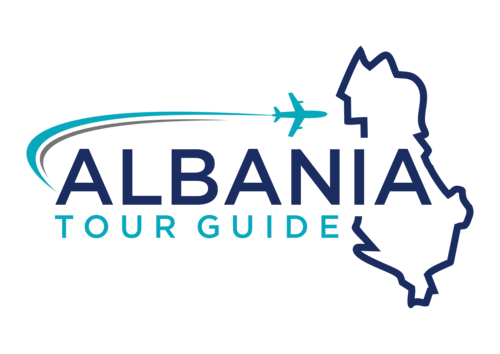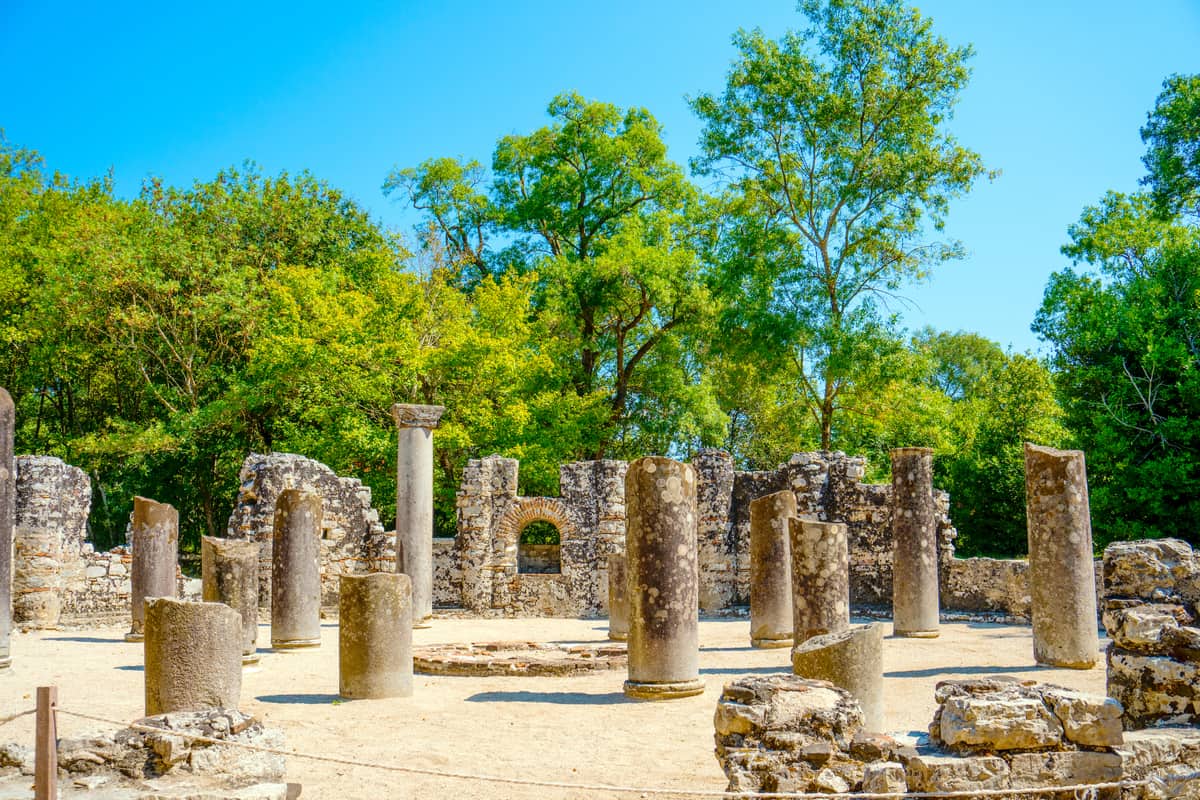
Albania Unesco Tour – 4-Day Mini UNESCO Tour in Albania
I really enjoy guiding the Albania Unesco Tour, because Albania’s Unesco heritage sites are stunning. Moreover, during the Albania Unesco tour, you will see so much more of Albania’s facinating history, culture and the beautiful beaches.
Why should I go on the Albania Unesco tour? The Albania Unesco tour gives you the chance to explore the most interesting Unesco sights in Albania. You will visit the archaeological park of Butrint, the ruins of Apollonia and the historical centers of Berat & Gjirokaster. And there is still plenty of time to enjoy the Albanian Riviera and highlights like Ksamil beach and the Blue Eye of Albania.
Albania is still a mystery for many tourists, but it has a lot of fascinating history, culture & gorgeous nature to offer. You can explore the Greek and Roman history, walk through a typical Ottoman town and enjoy the gorgeous beaches of the Albanian Riviera. Why not travel off-the-beaten-path to Albania this year?
Albania Unesco Tour Details
The Albania Unesco tour gives you a chance to explore all the most beautiful historical Unesco sights in Albania. During the tour, you will experience and walk through Albania’s history. Whilst also taking the time to relax and enjoy the beautiful places in Albania.
You will visit the Butrint Archaeological Park, which has stunning ruins from the Greek empire, the Roman empire, the Christian influences, the Byzantine empire and the Venetian rule. What is even more special is that the ruins have been surrounded by beautiful nature and the water of the lake, turning it into a sanctuary.
You will walk through the historical centers of Berat UNESCO city and Gjirokaster UNESCO city. Both cities have beautiful historical houses from the Ottoman period. You can walk on the old cobblestone streets and admire the architecture. You can stroll through the old bazaar market and buy local handicrafts. And hike up to the hill-top castle for a stunning panoramic view.
You will explore the Apollonia archaeological park, which was once an important Greek and Roman city. And you can imagine, what is was like from the impressive, large scale ruins.
But apart from the UNESCO sights and archaeology, you will experience so much more of Albania and its culture.
On you drive to the south of Albania, you will visit many of the hidden beaches of the Albanian Riviera. You will also explore the mysterious castle of Ali Pasha, which was built on a little island in the middle of the Porto Palermo Bay.
On the third day, you will have some free time to relax at Ksamil beach, which is a paradise-like beach in the south of Albania. And you will have the opportunity to swim or take a boat to one of the uninhabited Ksamil islands.
On the final day, you will see the Blue Eye of Albania, which is a fresh water spring with a magical blue colour. The spring resembles a human eye and it is truely unique to Albania.
If you would like to experience Albania’s history, see the Unesco sights and you would like to relax at the Albanian Riviera, then the Albania Unesco tour is perfect for you.
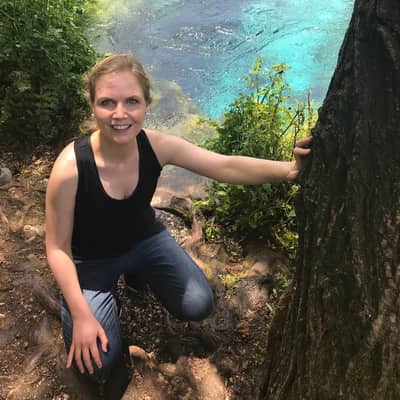
About me
I am an Albania Tour Guide, who organizes 1-day, 2-day or multiple day private tours in Albania. I arrange your transportation and I am your English speaking guide. So that, you get to experience the most beautiful places in Albania!
Kind regards, Manon

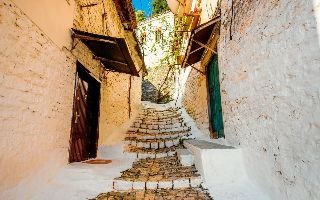
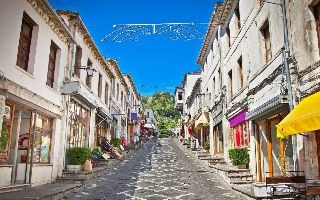
Albania Unesco Tour Itinerary
Below you can see the Albania Unesco Tour Itinerary. During the 4-Day Albania Unesco Tour, you will see many hightlights in Albania.
On the first day, we make a quick stop in the coastal town Durres for some historical sightseeing. Whereafter, we travel onward to the UNESCO heritage city of Berat, with the beautiful white houses from the Ottoman period.
On the second day, we drive further southwards along the beautiful beaches of the Albanian Riviera. And we stop at the Apollonia archaeological park, the Llogara Pass and the Castle of Ali Pasha.
On the third day, it is time for the UNESCO city of Butrint. Butrint is without a doubt the most impressive historical sight in Albania. I will guide you through the archaeological park in the morning. And in the afternoon, you have time to relax on Ksamil beach, which is the most gorgeous beach in Albania.
And on the fourth and final day, we explore the Blue Eye of Albania. Which is a stunning fresh water spring. And we walk through the historical UNESCO city of Gjirokaster.
The Albania Unesco tour combines all the highlights in Albania in only four days, whilst also giving you the time to relax and enjoy your time off.
Pick-up for the Albania Unesco Tour
The Albania Unesco tour starts in Tirana city. You will be picked up from a location of your choice in Tirana.
When you make the booking, you will be asked to type your pick-up location in the box. It is completely up to you. You can enter your hotel in Tirana, the airport or a location in the city center of Tirana.
Pick-up service in Tirana is included in the price of the Albania Unesco tour.
Day 1: Durres and Berat UNESCO sight
Roman Amphitheatre of Durres
The Roman Amphitheatre of Durres was build in the 2nd century AD. At the time, Durres was called “Dyrrachium” and it was a part of the Roman empire. The Roman Emperor Trajan was leading the empire and Rome was flourishing.
The Roman Amphitheatre of Durres used to host gladiator spectacles and other events. It was an attraction for the citizens, travelers and merchants. The theatre could seat approximately 15000 to 18000 spectators. The theatre was re-discovered only recently in 1966.
There is a Byzantine chapel in the amphitheatre with beautiful mosaics. And you can walk along the pathway above the theatre and look down onto the arena.
The Venetian Tower of Durres
The Venetian Tower of Durres is a large round tower which remains of the former Durres Castle. The castle was initially build in the 5th century by the Byzantine Emperor Anastasius. The Venetians extended the castle in the first half of the fiftheenth century, when Durres was ruled by the Republic of Venice.
Today, few structures of the castle remain, only the tower and one ancient wall can be seen. There is a little coffee house on top of the Venetian tower.
Berat Castle
When we arrive in Berat, we will visit the Castle of Berat. The Kala fortress is an enormous castle on the top of the hill in Berat. From the castle, you will have amazing views in all directions and you can see the historical town and river below.
Within the castle walls, you will see a village-like neighbourhood, called Kala. Until this day, some people are still living within the castle walls. The castle dates back to the 13th century and there are many Byzantine churches within the walls and one Ottoman mosque.
Holy Trinity Church in Berat
The Holy Trinity Church is one of the best preserved churches inside the Berat castle. It will be one of the first buildings you see, as you walk up the hill towards the upper castle. The church is very beautiful and quite an eye-catcher. It was build in the 14th-century and still remains beautiful until this day.
Museum of Iconography “Onufri”
The Museum of Iconography is a museum with religious painting from several Albanian monasteries. The museum is located within the castle walls in the largest church on the premises, called “the Church of the Dormition of St. Mary”. The museum is named “Onufri” after the Albanian fresco and icon-painter.
National Ethnographic Museum of Berat
Just down the hill from the Berat castle, we will visit the National Ethnographic Museum of Berat. The museum is inside a beautiful 18th century Ottoman house. On the ground floor, you can see a traditional medieval bazaar with embroidery, woodcarving and metalworking shops. On the second floor, you can visit a traditional house with a guest room, a kitchen and a work room.
Mangalem Quarter & Gorica Quarter
Then in the afternoon, we will visit the Mangalem & Gorica Quarters. These are the traditional neighbourhoods build on the side of the hill. You will see hundreds of little white Ottoman-style houses. From the bottom of the hill, it looks like the little houses are stacked on top of each other. Therefore, Berat is called “the city of a thousand windows”. In short, Berat is a very romantic city with an Italian atmosphere.
Free time to explore Berat
In the late afternoon, you will have some free time to stroll through the old neighbourhoods of Berat. You can buy souvenirs, sit down on one of the many terraces, take stunning pictures on the bridge and try some local food. Berat has many beautiful architecture and traditional houses, which have been turned into restaurants, shops and hotels. After seeing this beautiful city, you will no doubt understand why it is a museum city and a UNESCO Heritage Site.
Overnight stay in Berat
Day 2: Apollonia UNESCO, Llogara Pass and Ali Pasha Castle
Apollonia Archaeological Park
Apollonia is an archaeological park in center of Albania. In the ancient times, Apollonia was an important Greek and Roman city. The city was founded in 588 BC by Greek colonists from Corfu and Corinth. However, it was during the Roman period that the city of Apollonia really flourished.
In the 4th century AD, Apollonia was an important economic city and trade center. The city was known for its famous school of philosophy. Cicero, a famous Roman public speaker, called Apollonia “a great and important city”. And the city was also one of the most important gateways to the Via Egnatia, which was a Roman trade route through the Balkans.
The ruins of Apollonia were re-discovered in the beginning of the 19th century. The park is set of a hilly plateau and it is surrounded by calming nature.
Llogara Pass
The Llogara Pass is a high mountain pass on the coastal road along the Albanian Riviera. The Albanian Riviera is the coastal area with the most beautiful beaches in Albania. The coastal road starts in Vlore city and leads to the South Albanian city of Sarande.
The Llogara Pass is the highest point on the main coastal road, at a height of 1027 meters. It is a beautiful viewpoint, where you can make a stop for a coffee break. From the pass, you will have a spectacular view of Palase beach, the Dhermi village and the Ionian Sea.
After visting the Llogara Pass, we will drive down the winding road towards the most beautiful beaches of the Albanian Riviera. The riviera has Mediterraenean villages, historical castles, Orthodox churches, white beaches, hidden caves and hundreds of olive threes.
Dhermi beach
Dhermi beach is one of the most famous beaches in the Albanian Riviera. Dhermi is a lovely little village with hillside houses and a long stretch of beach. During the summer months, it attracts young people and it has a vibrant atmosphere.
Jala beach
Jale beach is a little beach village in the middle of the Albanian Riviera. The beach of Jale is known for its incredibly clear water. Jale is for people, who like a relaxed atmosphere and a pretty beach.
Himare beach
Himare is a larger village in the middle of the Albanian Riviera. There is a traditional village on the hillside, from where you can look down onto the beach and sea. There are several nice beaches surrounding the village.
Porto Palermo and the Castle of Ali Pasha
Porto Palermo is a large blue bay in the Albanian Riviera. In the middle of the Bay of Porto Palermo, you can visit the Castle of Ali Pasha.
The castle of Ali Pasha is a triangular-shaped fortress on a little island in the Bay of Porto Palermo. The castle is very picturesque and from the rooftop, you have a stunning view of the sea.
Although many guidebooks state that the castle was build by Ali Pasha, the Albanian governor during the Ottoman empire. It is actually not true, and the castle was build by the Venetians. Because it gave the Venetians easy access to the sea and it has the same triangular design as the Venetian castle in Butrint.
It is very likely that the written history was changed during the communist period. The communists wanted to believe that the Albanian Ali Pasha constructed the castle. Because it is more in line with the communist nationalist ideas. During the communism, the castle was used as a Soviet submarine base.
Saranda
Saranda is a vibrant coastal city in the south of Albania, close to the Greek border. The city is often called “the unofficial capital of the Albanian Riviera”. The large coastal city has a variety of restaurants, bars, clubs and coffee houses. In the evening, the entire city lights up and you can walk along the promenade by the water. You will have some free time in the evening to explore Saranda.
Overnight stay in a 3-star hotel in Saranda
Day 3: Butrint UNESCO sight and Ksamil beach
Butrint
Butrint is the most impressive UNESCO Heritage site in Albania. Throughout history, Butrint was a Greek city, a Roman city and a Biscopic. What makes Butrint special is the unique combinatation of archaeological ruins, which are surounded by water and nature. The nature has integrated itself in the historical sight, which makes it a beautiful place to visit.
Butrint is an archaeological park, where you can see ruins and historical buildings from all the different periods throughout history. Butrint was initially a prehistoric site, with its first occupation dating back to 50 000 BC. Then from 800 BC, it became a Greek colony. In 44 BC, it was taken over by the Romans, who built an aqueduct accross the Vivari channel to the main land. Then in the 5th century AD, Butrint was ruled by the Church and its Bishop.
In the 9th century, after briefly being abandoned, it was reconstructed by the Byzantine empire. In the 14th century, the Venetians controlled the site and strengthened the defensive works. And finally, Ali Pasha, an Albanian governer during the Ottoman empire, ruled the city. In the late middle ages, Butrint was abandoned.
Ksamil
Ksamil beach is a paradise-like beach in the South of Albania. Therefore, the Albanian people describe Ksamil beach as “the pearl of the Albanian Riviera”. Without a doubt, Ksamil beach is the prettiest beach in the country. The beach is set on a little peninsula with perfect white sand. And the water in the bay is a bright green colour and the clearest water you have ever seen.
At Ksamil beach, there are four little islands in the sea close to the beach. The most famous are the twin islands, which are connected to each other by a narrow strip of land. If you have always wanted to visit an uninhibited island, this is your chance. From the beach, you can swim to the nearest island. Or you can rent a boat or kayak to visit the islands, which are further away.
Overnight stay in a 3-star hotel in Saranda
Day 4: The Blue Eye of Albania & Gjirokaster UNESCO sight
Blue Eye of Albania
The Blue Eye of Albania is one of the most beautiful places to see in Albania. The Blue Eye is a natural fresh water spring. The natural spring pumps bright blue water to the surface of the river. The Blue Eye has become a touristic attraction, since the water of the spring is a magical blue colour. The water is so bright, that you won’t believe it is all natural.
Moreover, the spring resembles a human eye. The dark underwater cave looks like the black pupil of a human eye. And the bright blue water looks like the iris of a human eye.
If you dare, you can jump into the Blue Eye spring, which is more than 50 metres deep. But bare in mind that the water is ice cold all year long.
Gjirokaster city
Gjirokaster is a historical city, which is on the UNESCO heritage list. Walking through Gjirokaster gives you an insight into what the city was like during the Turkish Ottoman Empire. The city has typical stone houses and cobble stone streets. Therefore, Gjirokaster is also knows as the “stone city”.
The city of Gjirokaster is known in Albania as a “museum city”, because it has beautiful historical buildings everywhere. It is a lovely city to stroll through.
Gjirokaster Castle
The Gjirokaster Castle is a large fortress on the top of a hill in the city. The fortress has a spectacular view of the historical city and the traditional stone houses of Gjirokaster. It is one of the biggest hilltop castles in the Balkans and it therefore dominates the city.
The castle was originally build in the 12th century by the local Byzantine government. But it was renovated and additions were made during the Byzantine rule, the Ottoman empire and the government of King Zog. From the 1930 onwards, it was mainly used as a prison for people who were resistant against the government.
Inside the castle, you can visit the Museum of Arms, which displays arms used against the Italian occupation, the German occupation and the Albanian Independence.
Old Bazaar of Gjirokaster
The Old Bazaar of Gjirokaster is the traditional market place in Gjirokaster. The bazaar was originally build in the Middle Ages. There are a variety of craftsmen, souvenir shops and coffee houses along the Bazaar. You can buy handmade wooden pieces, handwoven rugs and delicate lace items. The street of the Bazaar is made of cobblestones and it set on a steep hillside.
Skenduli House
Skenduli House is a highlight for visitors of Gjirokaster. It is an original family house, which is more than 300 years old. During your visit, you will get a unique insight into what life was like for a rich family during the Ottoman period. The house has 9 fireplaces, 6 bathrooms, 12 rooms, 44 doors, 64 windows and 4 hamam turkish baths.
The house has been owned by the same family for generations. The family will show you around the house and tell you stories about it’s history. One of the highlights is the room used for wedding ceremonies, with beautiful stained glass windows, carved wooden ceilings and a fireplace decorated with pomegranates, which symbolize fertility.
Cold War Tunnel in Gjirokastra
The Cold War Tunnel is a giantic bunker underneath the castle of Gjirokaster. It was build by the former communist dictator Enver Hoxha.
The dictator was paranoid about a foreign invasion or a nuclear attack. In fact, he was so convinced an attack was eminent he constructed 750.000 bunkers all over Albania. The Cold War Tunnel was constructed in secret in the 1960s, and it remained a secret for the locals until the 1990s.
The Cold War Tunnel is 800 m long and it has 59 rooms, therefore, it could hold up to 300 people if needed. The bunker is empty, but the use of the rooms have been displayed on the doors. There were rooms for government ministries, interrogators, party elites, power generation, water storage, sleeping, de-contamination and air filtration.
Museum of Weapons Gjirokastra
Inside the castle walls of Gjirokastra’s castle, you can visit the Museum of Weapons. The museum site was originally a prison. Albania’s King Zog constructed the prison in 1932. During the second world war, the prison was used by the Italian and German forces. After the war, the communist regime, used the prison to hold political prisoners.
The Museum of Weapons displays arms used during the Albanian Independence struggle in 1912 and from the struggle against the Italian and German occupations from 1939 to 1944.
Zekate House
Zekate House is a historical town house in Gjirokaster city. It is a beautiful example of a traditional tower house. The house was build in 1812, and it said to be “one of the greatest examples of Gjirokaster architecture in the Ottoman style”. Impressive houses like Zekate House, used to only belong to the wealthy people, like government officials and merchants.
Inside the house you can see the original interior and imagine what it was like to live there during the Ottoman period. There are beautiful stained-glass windows, wooden ceilings and wall frescoes.
Obelisk Monument of Gjirokaster
The Obelisk is a monument located on the highest peak of the city of Gjirokaster. The monument is a symbol of education in the Albanian language.
For many centuries, Albania was a part of the Turkish Ottoman empire. Therefore, education in the Albanian language was forbidden for a long period of time. The Obelisk monument is located near the location of the first Albanian language school in Gjirokaster, which was opened in 1908. At the time it was very dangerous to open an Albanian language school, particularly for the teachers, who worked there.
Since the Obelisk monument is located on the highest peak in the city of Gjirokaster, it has amazing views. You can see the old city and the typical stone houses below.
Cerciz Topulli Square
Cerciz Topulli Square is a historical square in Gjirokaster. It is named after the national hero Cerciz Topulli, who fought against the Ottoman Turks in the early 20th century. He was mainly known for killing the Ottoman commander Bimbashi in 1908. Shortly after in 1912, Albania became independent and he fought to protect the Albanian territory from the foreign invators. There is a statue of the hero on the square.
Drop-off service after the Albania Unesco tour
After the Albania Unesco tour, you will be dropped off in Tirana city. It is completely up to you, we can either drop you off at your hotel, the airport or a central location in the city center of Tirana.
Drop-off service in Tirana is included in the price of the Albania Unesco tour.
Albania Unesco Tour highlights
There are many hightlights during the Albania Unesco Tour. The pictures below will give you a better idea, of the beautiful sights you will visit during the tour.
During the Albania Unesco Tour, you will visit the most important Unesco sights. But along the route to the Unesco sights, we will also visit other highlights, like Ksamil beach and the Porto Palermo Bay.
You simply cannot drive past the Bay of Porto Palermo, without wanting to make a quick stop to explore the castle on the island. Similarly, you cannot travel to Butrint, without stopping at the gorgeous Ksamil beach.
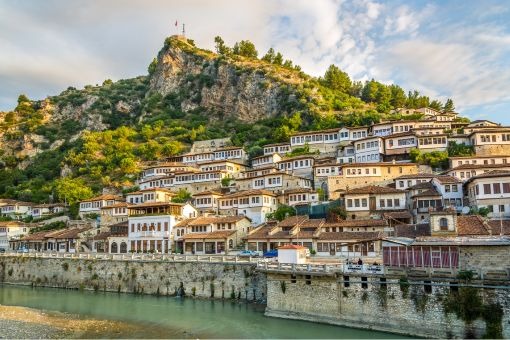
Berat UNESCO city
Berat is a romantic and historical city in the center of Albania. The city is known for its typical white houses on the hillside, that were built during the Ottoman empire.
The houses used to be inhabited by craftsmen and merchants in the past. And today, many of the houses have been turned into hotels, restaurants and cafes. You can walk through the cobblestone streets and experience Berat’s history.
You can also climb to Kala castle on the top of the hill, which has stunning panoramic view of the Berat city and with impressive mountains in the background.
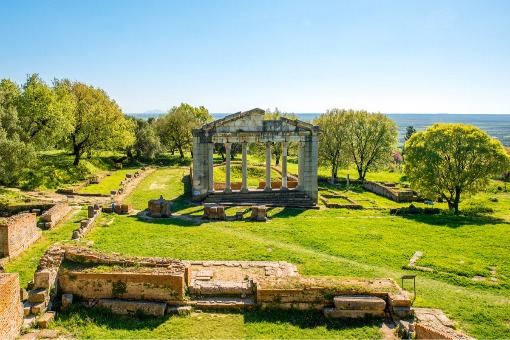
Apollonia archaeological park
Apollonia is an archeological park in the center of Albania, where you can visit the ruins of the ancient city of Apollonia. Apollonia was originally founded by the Greek colonists from Corfu and Corinth in the first half of the 6th century BC. The city was named after the god Apollo.
During the Greek and Roman empires, Apollonia became an important economic and trade center. The Roman philosopher Cicero called Apollonia “a great and important city”. The city was also an important gateway to the Via Egnatia traderoute accross the Balkans.
The city fell into decline in the medieval period and it was rediscovered in the beginning of the 19th century.

Porto Palermo Bay
Porto Palermo is a large blue bay in the middle of the Albanian Riviera. In the middle of the Bay of Porto Palermo, there is a little island with a triangular castle. The island is connected to the mainland by a narrow strip of land.
Many guide books state that the castle was built by the Albanian governor Ali Pasha, during the Ottoman rule. But it is actually much more likely that it was built by the Venetians, since it could be accessed from Sea. Moreover, the castle has the same triangular design as the Venetian castle in Butrint.
Most probably, the communists rewrote the history, because an Albanian constructing the castle fit better with their nationalist ideas.
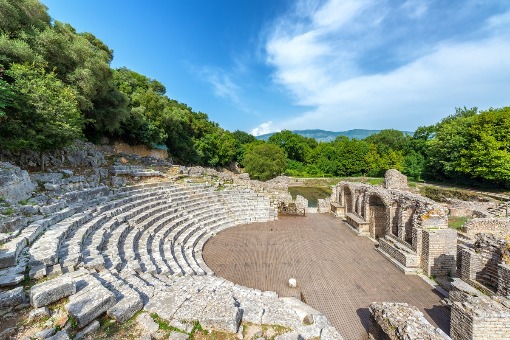
Butrint UNESCO site
Butrint is a beautiful archaeological park in the south of Albania. The park has a stunning combination of historical ruins, nature and the water of the lake surrounding the park.
Throughout history, Butrint was a Greek colony, a Roman city, a bishopric, a Byzantine city and a Venetian city. In the archaeological park, you can explore the different ruins from the different periods it was inhabited. Butrint is a UNESCO site and without a doubt the most interesting historical sight in Albania.
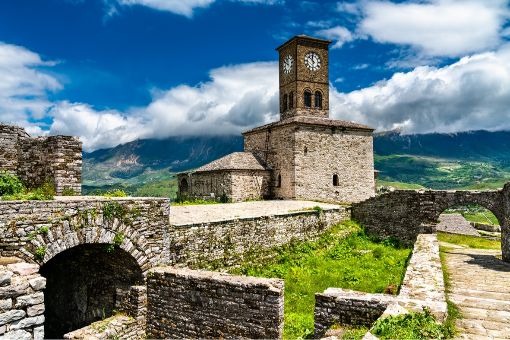
Gjirokaster UNESCO city
Gjirokaster city is a UNESCO heritage site, because of the beautiful stone houses from the Ottoman period. You can visit the Gjirokaster castle on the top of the mountain and you will have a beautiful view of the historical houses, built lower on the hillside.
Some of the historical houses, like Zekate House and Skenduli House, are open to the public. You can walk through a typical house and imagine what life was like for a rich family during the Ottoman empire. Furthermore, you can stroll through the old Bazaar market, which has local handicrafts and souvenirs.
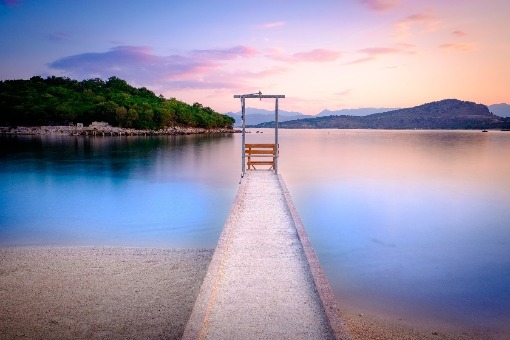
Ksamil beach
Ksamil beach is the most beautiful beach of the Albanian Riviera. The beach is set on a little peninsula with perfect white sand. In front of the beach, you can see four little Ksamil islands.
From the main beach, you can swim or rent a boat to visit the little Ksamil islands. The islands are uninhabited and very private.
Ksamil beach is how you imagine a paradise beach. Therefore, the Albanian people call Ksamil “the pearl of the Albanian Riviera”.
What is included in the Albania Unesco tour?
- Private transport with a/c vehicle
- Private tour guide
- Hotel pick-up and drop off in Tirana
- 1 night stay in 3-star hotel in Berat
- 2 night stay in 3-star hotel in Saranda
- Entrance fees to attractions described in the Itinerary
- 3 x breakfast
What is excluded from the Albania Unesco tour?
- Lunch and Dinner
- Tips and gratuities
At what time does the Albania Unesco tour start?
The Albania Unesco tour starts at 8:30 AM from Tirana city.
You will be picked up from a location of your choice in Tirana. When you make the booking, you will be asked to enter your pick-up location in Tirana. You can either enter the name of your hotel, the airport or a central location in the city center.
What is the duration of the Albania Unesco tour?
The Albania Unesco tour lasts 4 x full days.
On the first day, you will be picked up between 8:00 AM and 8:30 AM from your hotel in Tirana. And you will stay overnight in a guest house in Berat.
On the second day and third day, you will stay overnight in Sarande city.
On the fourth day, you will vist the Blue Eye of Albania and Gjirokaster city. These sightseeing locations are both in the South of Albania, after which we will drive you back to Tirana in the center of Albania.
Therefore, the Albania Unesco tour will finish late on the fourth day.
Where is the pick-up location for the Albania Unesco tour?
When you make the booking for the Albania Unesco tour, you can enter a location of your choice for pick-up in Tirana city.
When you fill out your booking details, there will be a box, where you can specify your pick-up location. It is completely up to you, you can enter the name of your hotel, the airport or a central location in Tirana as your pick-up location.
Pick-up service in Tirana is included in the price of the Albania Unesco tour.
Where is the drop-off location for the Albania Unesco tour?
After the Albania Unesco tour, you will be dropped off in Tirana city. You can be dropped-off at your hotel, in the city center of Tirana or at the Tirana International airport.
Drop-off service in Tirana is included in the price of the Albania Unesco tour.
Can I bring luggage on the Albania Unesco tour?
Yes, you can bring 1 or 2 pieces of luggage on the Albania Unesco tour.
If you have more luggage, you might be able to store them at your hotel in Tirana and collect them upon your return from the Albania Unesco tour.
Is the Albania Unesco tour a private tour?
Yes, the Albania Unesco tour is a private tour. During the four days of the tour, you will travel in a private vehicle.
Moreover, I am your private tour guide throughout the 4 day tour.
Since it is a private tour, you will also have the freedom to customize the itinerary to meet your preferences. For instance, we can spend more time at a touristic sight, if you wish to do so.
Can I customize the itinerary of the Albania Unesco tour?
Yes, you can customize the itinerary of the Albania Unesco tour. The Albania Unesco tour is a private tour, which includes private transportation. Therefore, you will have the choice to customize the itinerary as you please.
For any questions regarding customizing your tour, you can contact me on contact@albaniatourguide.com. Or you can book an Albania Planning Session via skype, by clicking this link.
Does the Albania Unesco tour include a tour guide?
Yes, I will be your private tour guide during your Albania Unesco tour. I will personally guide you during the sightseeing at all the Unesco heritage sights.
Moreover, you will travel by private transportation during the Albania Unesco tour, therefore, you will have the flexiblity to customize the itinerary if you wish.
What should I bring on the Albania Unesco tour?
The essential items to bring on the Albania Unesco tour are:
- Walking shoes
- Swimwear
- Sunscreen
Walking shoes
During the Albania Unesco tour, you will walk a lot through the historical cities and archaeological sites in Albania. Some of these sites are uneven or layed with cobblestones. Therefore, you will definitely need some comfortable walking shoes for the Albania Unesco Tour.
Swimwear
Although, we will visit stunning historical sites. There will still be plenty of opportunities to swim in the sea and relax at the beaches along the way.
Sunscreen
The archaeological sites and the hill top castles in Albania are explosed to the sun. You do not want to miss exploring these amazing historical locations, but you will definitely need protection from the strong sun.
When is the Albania Unesco tour available?
To check the availability for the Albania Unesco tour, you can press on the Book Now button below.
When you press on the Book Now button, you will first see a description of the tour and itinerary. If you scroll down, you will see another Book Now button, which will take you to a calendar with the available tour dates.
What is the best time to go on the Albania Unesco tour?
The best time to go on the Albania Unesco tour is all-year-round. The historical cities and archaeological parks are open throughout the year.
In the summer, you will have the opportunity to swim in the sea, as the sea water is of a nice temperature. However, exploring historical sites and cities can be very enjoyable, if the temperature is a little bit less hot.
Moreover, if you travel before or after the high season, you will have more privacy at the sightseeing locations.
What if my preferred date for the Albania Unesco tour is not available?
If you have pressed on the Book Now button, but you could not find your preferred date for the Albania Unesco tour, you can get in touch by email.
You can email me on contact@albaniatourguide.com . Please specify the date, number of travellers and the tour you would like to book in the email. Then I will get back to you with a response as soon as possible.
What is the price for the Albania Unesco tour?
You can check the price for the Albania Unesco tour by clicking on the Book Now button below. First, you will see a description of the tour and itinerary and if you scroll down, you will see the tour price per person.
How can I book the Albania Unesco tour?
- Press on the “Book Now” button
- You will see a pop-up with the tour description and itinerary. Scroll down and press “Book Now” at the bottom of the page.
- Select the date of your tour and pick your departure time.
- Select the number of adults and press “Add to Cart”
- Press the “Check-out” button to continue
- Enter your email address, first name, last name, phone number and your preferred pick-up location. Then please accept the terms of service and the privacy policy by ticking the boxes. And press on the “Continue” button.
- You can complete your payment with a credit card, a debit card or with Apple pay.
- As soon as your booking has been completed, you will receive a booking confirmation by email within minutes.
If you have any questions about your booking, you can email contact@albaniatourguide.com . And I will personally respond to you as soon as possible.
How late can I make a booking for the Albania Unesco tour?
You can make a booking with me up until the day before the tour starts. Just keep in mind that the Albania Unesco tour may not be available, if you book at the last minute!
Especially, since I lead the private tours through Albania personally, so I cannot take more than one booking on each date.
I recommend booking at least one week in advance, in order to have the best chances of finding availability.
What is the cancellation policy of the Albania Unesco tour?
We will charge a cancellation fee of 100% if booking is cancelled 1 day or less before the event.
Where can I ask a question about the Albania Unesco tour?
If you have any questions about the Albania Unesco tour, you can reach out by email. My email address is contact@albaniatourguide.com.
I will personally respond to your email as soon as possible.
